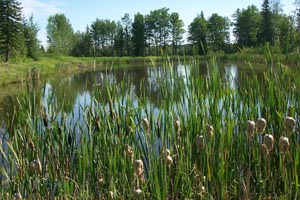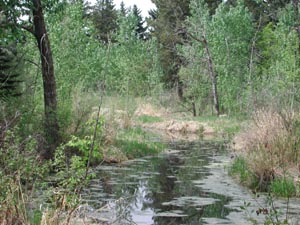| | Woodlots and wetlands are integral parts of the Alberta agricultural landscape and its natural ecosystem. Many landowners have a strong sense of stewardship for their land. They want to do the right things to sustain their land for themselves and for future generations. By carefully managing their private woodlots and associated wetlands, wood production and other land values will be maintained for many years to come.
A wetland is an area, which is wet or flooded either periodically or all year round. Many people have traditionally viewed wetlands as wastelands but there is an increasing realization that wetlands perform a number of critical functions. Wetlands reduce the impact of flooding, control erosion, purify water by removing sediment and nutrients and contribute to groundwater recharge. Wetlands also provide very important and diverse habitat for many different species of mammals, birds, reptiles, fish, insects and plants.

Woodlot around wetland
The area next to the water is called the riparian zone. It is also important in the ecology of an area. Naturally vegetated riparian areas reduce the amount of sediment and nutrients entering wetlands and streams and provide habitat benefits to fish and other wildlife. Sediment can damage fish spawning habitat and reduce food supplies for fish resulting in lower fish populations. Shoreline vegetation provides shade, reduces water temperature and improves habitat for fish.
Riparian habitats are also important to a variety of other wildlife. Woodlots located near water provide nesting habitat and cover for many bird species including water birds (ducks and shorebirds) and songbirds. A noted riparian habitat resident is the beaver. Although beavers are sometimes considered a pest, they are ecologically important. Beaver ponds support a variety of waterfowl and other mammals such as, muskrats, mink and otter. By cutting trees, beavers increase the abundance of shade-intolerant shrubs, which increases shrubby forage production for moose, deer and hares.

Woodlot along creek
Riparian areas provide important wintering habitat for moose and deer because of abundant forage and cover. Wildlife movement corridors also frequently follow forested riparian areas. In order to maintain the important functions of wetlands and riparian zones woodlot owners can adopt and practice the following management activities:
- Do not drain or fill any portion of a wetland.
- Avoid forestry operations in riparian areas as much as possible. If necessary use single tree or small patch harvesting methods to reduce negative impact from any operations in the riparian zone.
- Reestablish the vegetation in riparian zones by planting appropriate trees or shrubs.
- Leaving snag trees, “wolf” trees and naturally fallen trees. These trees provide important habitat for many wildlife species.
- Fence off wetlands and riparian areas to prevent livestock from using these areas for watering or grazing. Use remote watering systems to improve water quality for livestock.
- Build proper bridges or use portable bridges for machinery or livestock stream crossings.
- Avoid or minimize activities during the critical periods for wildlife. Consult local Fish and Wildlife personnel for critical time periods.
- Control grazing intensity (the number of livestock and the duration of grazing) to reduce grazing impacts in the riparian zone.
For more information on wetlands please contact:
Brian Ilnicki
Team Leader
Ducks Unlimited Canada
Box 1270, 5006-48 St.
St. Paul, AB T0A 3A0
Phone: 780-645-4767
For more information on woodlots please contact:
Toso Bozic
Sustainable Woodlot Specialist
Alberta Agriculture & Forestry
RR 6, 17507 Fort Road
Edmonton, AB T5B 4K3
Phone: 780-415-2681
Fax: 780-422-6096
Cell: 780-940-6107 |
|